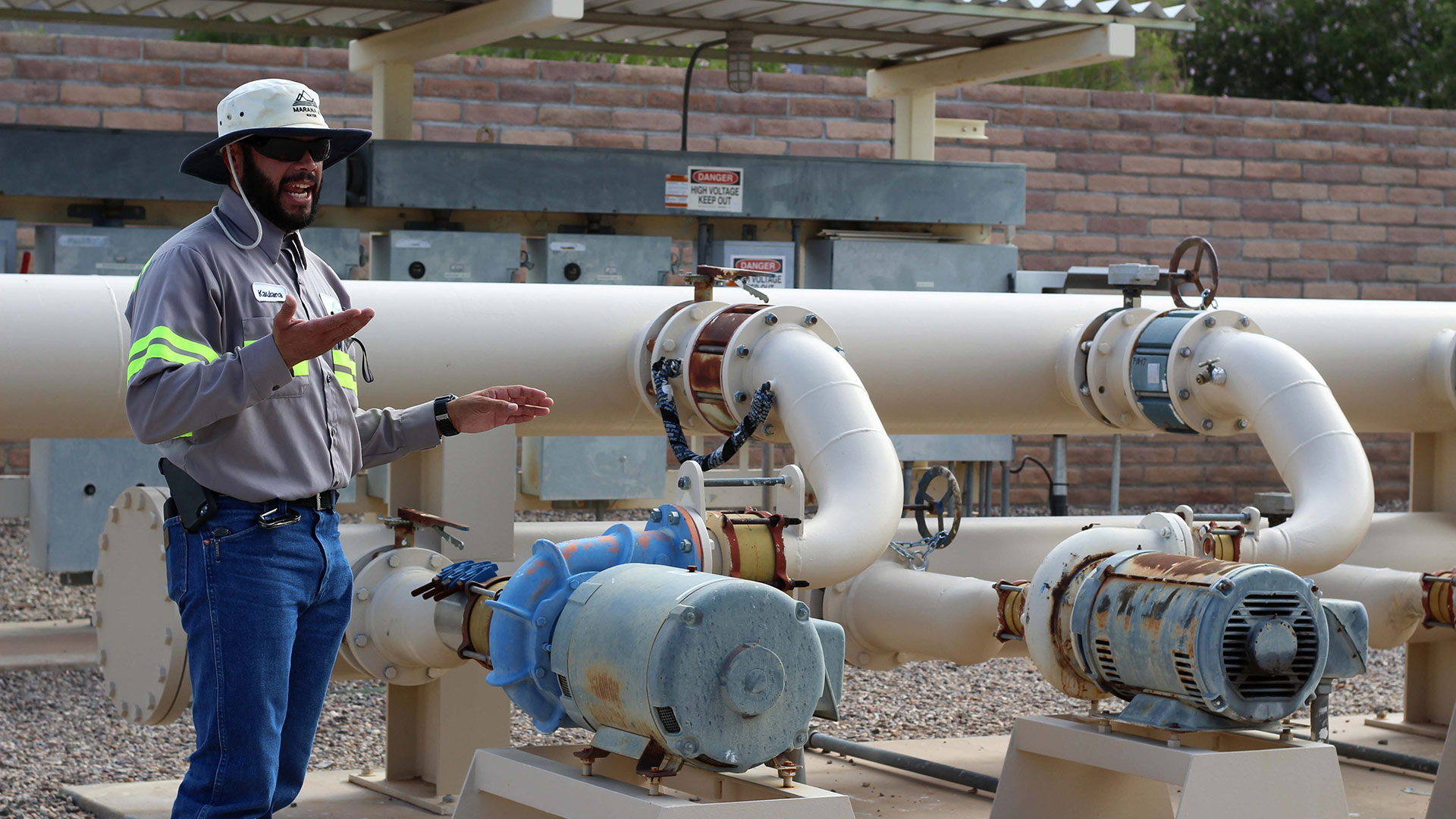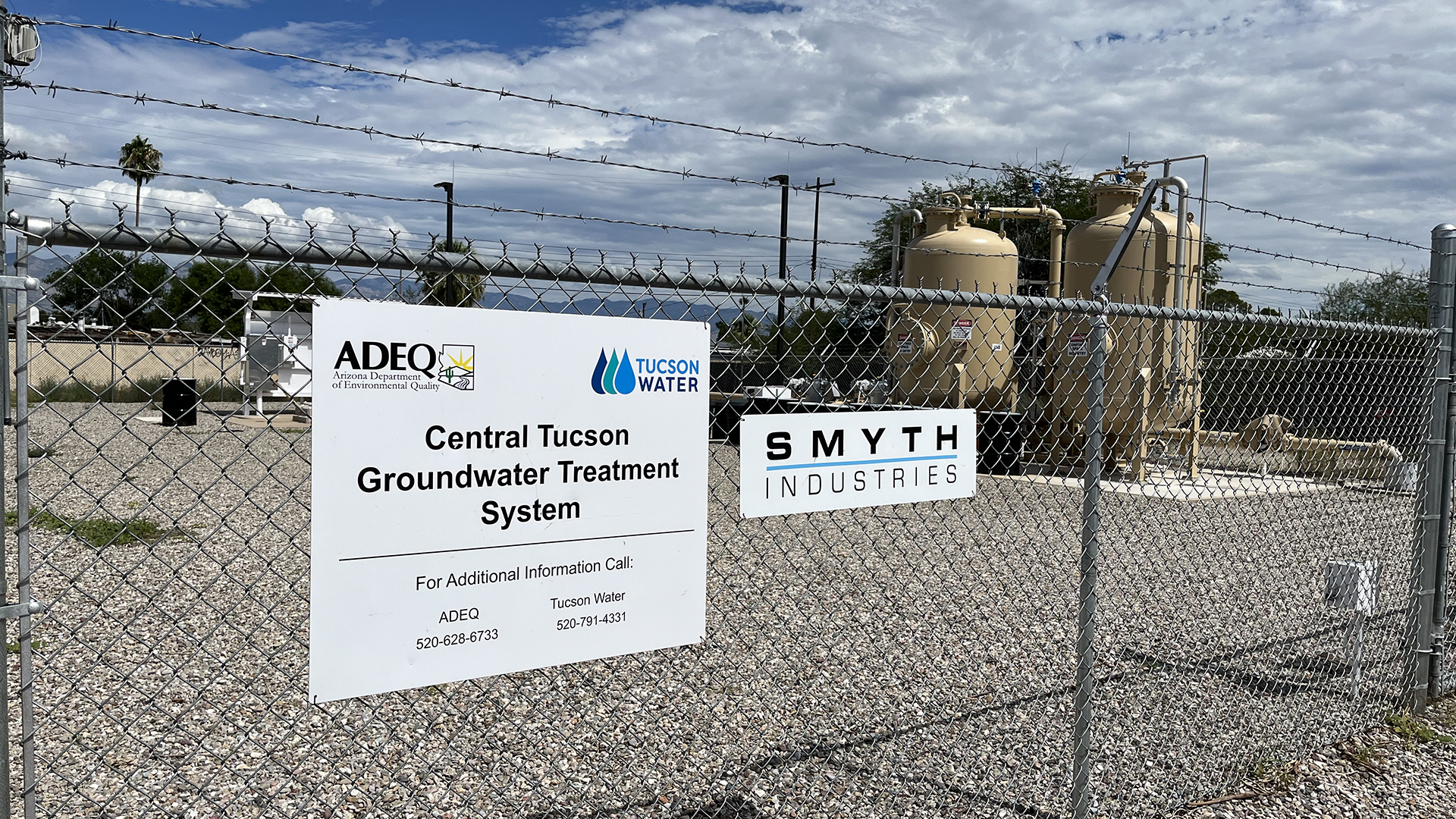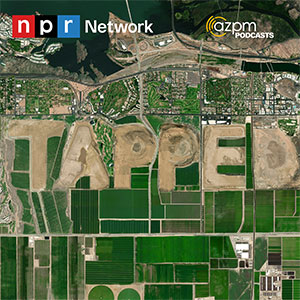 Water Quality Specialist for the Town of Marana Water Department, Kaulana Breitenbach at the Marana Picture Rocks Water Treatment Campus on Thursday, August 10. The water treatment facility has about 18,000 service connections for a population of 50,000.
Water Quality Specialist for the Town of Marana Water Department, Kaulana Breitenbach at the Marana Picture Rocks Water Treatment Campus on Thursday, August 10. The water treatment facility has about 18,000 service connections for a population of 50,000.
Season 2, Episode 2: How Water Gets to (most of) Us

In episode two of this season, we learn about how the small water companies that dot Arizona get water from the ground to customers, and what happens when a well breaks down.
Episode transcription
ZZ: In Pima County alone, there are more than 170 public water systems. Some are big, like Tucson Water, which has more than 700,000 customers.
But most of them are small. Some serve just a neighborhood, with maybe a couple-hundred customers or even less.
A small company means not a lot of money and tight margins. And wells are not cheap. A domestic well costs tens of thousands of dollars, let alone a municipal well.
(theme music fades in)
So it's easy to wonder how water companies that don't have a municipal government backing them keep the wells running. And what happens when one breaks?
This is Tapped, a podcast about water. I’m Zac Ziegler. On this episode, what goes into running the small water companies that dot our state?
(theme fades out)
Joining me now is AZPM environmental reporter Katya Mendoza. Welcome, Katya.
KM: Hi Zac, thanks for having me.
ZZ: So, how did you get started on this topic and why?
KM: Well, let’s start with a Why. Back in March, the only drinking water well in the unincorporated community of Why, went dry.
The well failed because of a hole in the casing– most likely due to rising surface water temperatures that caused premature deterioration of equipment.
The Why well maintenance operator Bill Hadley said wells should last somewhere between 40 and 50 years, but in this area, because the water temperature sits at about 103 to 105 degrees, once it reaches the surface. Instead of cooling down, it remains hot.
Hadley said pumps and motors only last for about 3 to 5 years.
ZZ: So less than one tenth of the expected lifespan. That just boggles the mind! I'm guessing that this is one of those small water companies I talked about in the intro. About how many residents depend on this public water system andow were they getting water?
KM: Hadley said about 110 residents as well as a well-staffed border patrol station nearby and RV Park which sees anywhere between 300 to 400 seasonal visitors.
The community had been hauling in water from the nearby town of Ajo, which had become quite expensive. It cost about $360,000 dollars just to bring in the water. That was 60% of the total cost of this entire situation.
ZZ: What's the story on how this got fixed?
Towards the end of May, the Why Domestic Water Improvement District aka DWID, asked the Pima County Board of Supervisors to declare a state of emergency for the area of Why in hopes of receiving financial support.
Hauling water on top of well maintenance fees had created an unsustainable financial burden.
As soon as the DWID knew the well was going to be down for more than a day they called Arizona Department of Environmental Quality, the local fire station and Border Patrol, as well as other board members.
After about three months and $560,000 dollars later, they were able to install a new eight-inch steel casing, which has been working fine ever since. Hadley said that they also revised their emergency operations plan to include more names of resources as well as ensuring maintenance happens more frequently, every three to five years instead of five to six.
The well was fixed in June, through combined efforts between communication and collaboration between the Why DWID, ADEQ, Pima County Department of Environmental Quality (PDEQ).
ZZ: How were they able to fund this expensive endeavor being such a small company?
KM: The Why DWID received a $50,000 dollar grant from ADEQ to help fund the new equipment and, received a $200,000 dollar grant from the National Rural Water Association to help cover costs.
I will also mention that because the Why DWID is working with a smaller budget for water, and because they’re a public district, their rates only cover basically what it costs to run every year.
Every district is different based on their population, cost of running, etc.
Hadley said that Why is up to about 111 water meters in town, so the cost of running the district has to be divided up between those 111 customers. So it’s a balancing act of trying to keep costs low and the service low enough.
ZZ: So what happened with the request to declare a state of emergency?
KM: Hadley had said the Why DWID was advised by various groups of people, that due to their financial situation and length of the well being down, that it was probably time to declare an emergency. But they found out that technically, it is not an emergency, until there is no water for four hours.
I will say that Hadley mentioned that the Why DWID is in the process of getting some serious funding from the USDA Rural Development office to drill a new well and build a new treatment plant, which they’re hoping will be completed over the next two to three years.
ZZ: How much is the funding for that project?
KM: They’re looking at about $6.2 million dollars. They’ve submitted the applications, paperwork, preliminary engineering report and are now just waiting for USDA approval so they can start the process of getting a bridge loan to start designing.
ZZ: Alright let's take a step back here to just this overall project. What is a DWID exactly?
KM: A DWID is like a governing board. Hadley, who I mentioned earlier, was a board member of this DWID. PDEQ Environmental Quality Manager Jennifer Lynch says DWIDs used to be overseen by the County Board of Supervisors, but to avoid a conflict of interest, the board has stepped back and the DWID board members are elected typically.
Jennifer Lynch quote: So, now we have seven DWIDS that meet the threshold of 50,000 customers or less that have been transferred as of May 29, 2023, from ADEQ to PDEQ and now we have primacy for those systems.
KM: This led me to the Marana Picture Rocks Water Treatment Campus. It’s really inconspicuous, it’s right behind a sports bar, a Lutheran church and a pet supply store, in between a community park that I actually used to play at when I was younger. My parents live in the area and get their water from that facility as it turns out.
So believe it or not, not a lot of people know where their drinking water comes from or how it’s treated. Although people have definitely heard the term PFAS, the Marana Public Water System is one of the few facilities in Pima County that treats for PFAS.
ZZ: I've been to a PFAS treatment site operated by Tucson Water for another AZPM show–I'm going to throw in a shameless plug for an episode of The Buzz from last September. We were by Tucson International Airport, and it was surprisingly small, it was like an oversized residential home lot. What was this site like?
 The Central Tucson Groundwater Treatment System, located near Davis Monthan Air Force Base, removes PFAS contaminates from the aquifer below the area.
The Central Tucson Groundwater Treatment System, located near Davis Monthan Air Force Base, removes PFAS contaminates from the aquifer below the area.
KM: Well if you travel up a dirt road you’ll reach a huge water storage tank and other large, tan painted structures. Normally the gate would be closed, but I was greeted by Kaulana Breitenbach from Marana Water and Jennifer Lynch from PDEQ and a few other water quality specialists at the Picture Rocks site to talk about how drinking water is treated and how a public water system is maintained.
(WALKING ON GRAVEL)
KM: Kaulana showed me the ropes and the step-by-step process of how groundwater is treated.
KB: Today we are at the Picture Rocks water treatment campus, this treats both for PFAS and one four dioxane using U-V-A-O-P and granular activated carbon…we’re taking it down to less than 0.001%, so parts per trillion, we are doing a magnificent job over here.
I would say this would be the start of our process, this is our well head, it’s bringing up well from the ground from the aquifer. I would like to say that this is probably about 400 feet deep and it pulls water around 280 feet deep and it’s coming up as raw water, no treatment, no anything at first, it comes across this header well right here, as you come across this way, this is pretty much the start of our treatment.
ZZ: Now Kaulana mentioned raw water, what does that mean?
KM: So in this instance, it’s water with contaminants or sediment such as sand and rocks. In 2018, the Town of Marana Council made the decision to construct a water treatment facility for two impacted systems in Marana Water that were found to contain unregulated compounds of PFAS and 1, 4 dioxane.
These unregulated compounds currently do not have a Maximum Contaminant Level applied by EPA, but do have applicable health advisories.
ZZ: Walk me through the process of treating this water.
KM: So we entered the sedimentation zone . . .
(KB: This is pretty much the start of our treatment)
KM: where de-sanders remove big things that you can see with your eyes such as rocks, debris, sand, everything like that. And from there…
KB: Our bag filters that we have there, it removes I would say like the silt and finer things that we have. Once it goes through there, where you see that silver line right there, that’s our static mixer. That’s where we enter in our 35% less than hydrogen peroxide, it turns the water over. So now our water when it comes through here is sediment free and we are putting initializing the hydrogen peroxide.
ZZ: So you’re at the water treatment facility, what do some of these structures look like?
KM: The way Kaulana described it, if you’re looking at the well, you’re looking at a 200-horsepower pump motor . . .
KB: That goes down and travels down off the top of my head I want to say at least 400 feet.
KM: Inside there’s a casing with certain perforations, or holes, between 100 and 200 feet and when that pump turns on . . .
KB: There are bowls way, way, way down there.
KM: They fill up with water from the aquifer. The pump sucks it up from there, and it comes across the wellhead and past
KB: That blue thing that you see right there . . .
KM: a check valve.
KB: So as soon as the water goes past there and it pumps it out, it can't come back. So long as there's positive pressure coming from our wellhead, it continues out as soon as the wheel turns off, it stops all the water right there, the remaining fall down in there, but that’s pretty much how that well motor operates. It gets oiled, whenever it turns on we have to oil it to make sure that it doesn’t have too much heat and blow up.
JL: Imagine a casing is just a large tube that runs from the ground surface down to the aquifer and it’s a way to siphon the water from the aquifer up, up top to have us be able to access it. So imagine a tube if it’s completely solid, that the pressure is going to be a lot better and easier to draw the water up. If there’s any holes or perforations in that casing, it’s going to allow sediment to infiltrate the casing and contaminate the water and you’re just not going to have enough pressure to draw that water up, and that’s what happened in that case with Why DWID.
ZZ: Okay, so that’s a well head in a nutshell.
KM: Correct, I happened to ask Kaulana how long the equipment is supposed to last, and he said everything has a shelf life but depending on preventative maintenance it could run anywhere between five and 20 years.
ZZ: We heard about those hot temperatures in Why earlier. Arizona has some pretty extreme temperatures and these pumps are outside. How does that factor into maintenance?
KM: He said that does affect the life of the machinery, which is why there is a shade structure covering the well head.
KB: When the motor is actually running, it does help keep the heat from the motor itself that it creates, with the outside ambient heat, this shade structure keeps it cool enough to where it doesn’t ever have to worry about overheating or getting too hot to where it can’t do its job.
ZZ: So who’s in charge of maintenance?
KM: So public water systems may be publicly or privately owned. Or even federally, such as the one at Davis- Air Force Base. Jennifer Lynch says it depends on the organizational structure of the water system.
JL: Some are co-ops, some are HOA’s, some are municipalities like this, some have a well-share agreement between all the users, and there isn’t a lot of structure and those are the ones that I would say we have the most interaction with because they’re small systems, they have a certified operator, but the day to day stuff they’re not really involved with so that’s where we get involved to sort of help them out.
KM: Since PDEQ oversees 172 systems, they do send out inspectors and conduct anywhere between 50 and 60 inspections a year.
They look at motors, piping, items in the piping such as check valves, cleanliness, that the property is fenced, they’re following checklists.
ZZ: So, in my reporting on other stories, I've found a lot about well regulation is done at the state level by either Arizona Department of Environmental Quality or maybe the state Department of Water Resources. How did this job end up with the county instead?
KM: The state delegated certain duties and functions for public water systems to Pima County, and one of those duties is sanitary surveys.
JL: We need to account for all of the structures that are on the property storage tanks, booster pumps, chlorinators, those sorts of things. I'd say a fair amount of the work is done ahead of the inspection, and then really it’s the boots on the ground, just verifying the information that we have and making sure that it’s correct. Again, they have to submit monthly samples to the state so we know they’re up to date on all of their sampling and they’re not exceeding any of the MCLS or maximum contaminant levels.
ZZ: Alright, we've heard about a lot of equipment and moving parts. This story started with a well not working. So what happens if something breaks?
KM: Great question, I asked Kaulana the same. They have an emergency plan. There is a spare wellhead motor that’s available and while they might lose a day’s worth of water, there’s another source nearby.
KL: Actually, we have a different well about, I would say roughly 300 yards more east of this that also feeds into this treatment campus. So where you see this line coming in for that valve is right there. That’s where one feeds like that. So one well turns on and the other well turns on. So if this well would go down, we pretty much turn it off and the other one would take over in its place while this one were to be fixed and then it would go back into rotation and we’d start the process all over again. So we might lose a day with this motor, but we wouldn’t lose actually any water flow or any demand loss, we would have it covered completely.
KM: Kaulana said that when they first started doing this treatment campus, they had to rebuild the well motor itself, supposedly the initial wiring was faulty and ended up frying itself whenever it was turned on. That was the most recent event and that happened about three years ago.
Louis Valencia, the Chief Water Quality Operator, said that there are also plans to tie this water system into another water system.
LV: So that would help a lot as far as capacity to provide water to this area and a plus sign on that is it’s actually not contaminated water.
KM: It’s a couple of wells, the Hartman-Vista water system, all owned by the Town of Marana and one day they will become one. It’s just a matter of connecting and talking to each other and Pima County approval.
ZZ: What’s the benefit of that happening?
KM: Water supply, redundancy and the non-contaminated well sources to the east.
Not all aquifers are contaminated with PFAS and 1, 4 Dioxane, the plume doesn’t exist out there.
ZZ: PFAS is a huge issue right now. Out of curiosity, How common is it for water systems to have to clean it out of the water?
KM: Well, ADEQ sampled 102 systems recently, and about a quarter have PFAS detections with a few test results still outstanding. These numbers come from single samples that began in late February. ADEQ will begin sampling for a second time at least 90 days after the first system.
Jennifer Lynch says that each system has monthly sampling for total coliform, which is a a group of bacteria, parasites, viruses or pathogens.
JL: There’s a variety of other contaminant samples that need to be taken, for example lead and copper that’s done– each water sample has its own sampling scheduling depending on past results. So some water systems only sample once a year for lead and copper, others are twice a year. It kind of depends, each one is a customized sampling plan.
KM: In 1991, the EPA enacted guidelines to test for lead and copper levels in residential properties.
Just a few years before the Marana Water Department was established, in 1997.
And before that, in 1974, there was The Safe Drinking Water Act, which is a broad federal regulation that dictates certain standards for drinking water systems throughout the country.
JL: Everything is a tiered approach. So the Drinking Water Act is promulgated by the EPA and they delegate the drinking water program to ADEQ and then ADEQ delegates it to the counties throughout Arizona to do the day to day operations
KM: So everything that we’re seeing here.
ZZ: So what happens if a customer calls their utility or the county with a complaint about water, maybe it tastes funny or looks gross or there's no water pressure?
KM: The way Lynch describes it is that maintenance operators are pretty much on call, they really strive to have a local connection so they are able to go out into the field and test for things like that. Of course, the farther certain customers are geographically, the more challenging it is to feel a connection.
KM: Kaulana did say something about day to day operations depend on any given day.
KB: Some days where I would come to work and I’ll take samples of the PFAS, 1,4 at the wellhead at our treated water, after treatment there are days that I come to work and I do backflow inspections and backflow input of data on the data portal that we have. There are days where we come to work and I do tours and stuff like this and I train kids on water usage and the water flow of water at schools.
KM: He said mostly third and fourth graders do the tours…
KB: A lot of their questions is mainly where water comes from and do I drink like poop water, so that’s the main thing of like letting them know you don’t drink recycled poop water, you don’t drink anything like that. Water pretty much falls from the sky, eventually hits the ground, through time it will go through its own treatment through the ground, gets stripped of all its minerals, whatever it can be and it ends up in our aquifer years from now and we’ll eventually pump that up. And that’s the water that we drink, like water that we’re drinking now is from years and years ago that has trickled down to the aquifer.
ZZ: Leave it to the tweens to ask the important questions, and thankfully, Kaulana has a concise answer ready to go.
KM: Absolutely, curiosity knows no age.
ZZ: Katya, thanks for taking us to the kind of place that most of us get our water from and telling us how it gets to our pipes.
KM: Thanks for having me! Until next time, keep those questions flowing!
(theme music fades in)
ZZ: Tapped is a production of AZPM News.
This episode was mixed by me, Zac Ziegler.
Our editor is our News Director, Christopher Conover.
Our theme music is by Michael Greenwald.
Visit our website in the podcast section of azpm.org for pictures, links and more. Thanks for listening.
(music fades out)






By submitting your comments, you hereby give AZPM the right to post your comments and potentially use them in any other form of media operated by this institution.